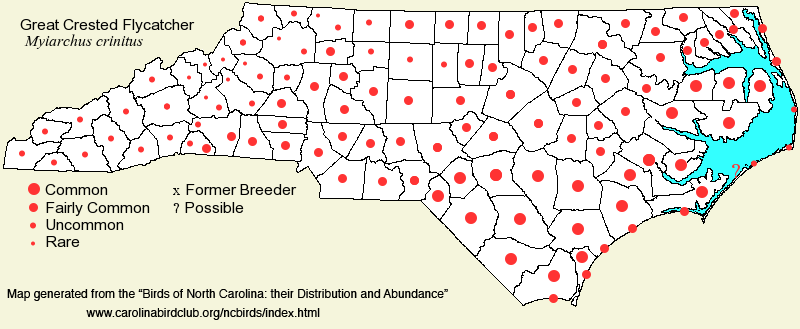 |  |
|
Great Crested Flycatcher - Myiarchus crinitus TYRANNIDAE Members: | Search Common: Search Scientific: |
|
|
|||||||
| General Comments | The Great Crested Flycatcher, like the Eastern Wood-Pewee and Acadian Flycatcher, is a species that nests essentially throughout the eastern United States, as well as presumably nesting in all 100 North Carolina counties. Unlike those two, however, it is not nearly as evenly distributed across the state, being quite numerous in the Coastal Plain but not common in the mountains, where one can spend a few days without seeing or hearing one. It is the only flycatcher in the state that nests in cavities (only); instead of creating their own, they use old woodpecker cavities and even bird boxes for nesting sites. Its breeding habitat is a varied array of forests, though slightly favoring drier habitats -- dry pine-oak forests, open longleaf pine forests, oak-hickory forests, and bottomland and swamp forests. It tends to avoid areas with spruce or fir. It also nests in wooded residential areas, especially in the Coastal Plain. | ||||||
| Breeding Status | Breeder | ||||||
| NC BRC List | Definitive | ||||||
| State Status | |||||||
| U.S. Status | |||||||
| State Rank | S5B | ||||||
| Global Rank | G5 | ||||||
| Coastal Plain | Summer resident and transient. In summer, generally common throughout the province, even nesting on barrier islands, where suitable forests are present. More numerous in the southern half of the province, especially the Sandhills and other areas where longleaf pines dominate; fairly common to common in the northern counties of the province. Mainly early or mid-Apr to late Sep; casual in winter. Winter records: one at Wanchese (Dare) on a CBC, around 1970; one at Beaufort on a CBC, 18 Dec 1983; one at Roanoke Island (Dare), 5 Dec 1999; and one photographed at the north end of Pea Island NWR on 19 Dec 2022. The sight reports were all seen by experienced observers, though photos are lacking; there is possible confusion of this species (especially in winter) with Ash-throated Flycatcher and with Brown-crested Flycatcher (not yet recorded for the state). Peak counts: ? | ||||||
| Piedmont | Summer resident and transient. In summer, fairly common essentially throughout; likely uncommon in the foothill ranges. Primarily mid-Apr to mid- or late Sep. No winter records. Peak counts: ? | ||||||
| Mountains | Summer resident and transient. In summer, uncommon over most of the region, but fairly common locally (in parts of the southwestern mountains). Occurs mainly up to 4,000 feet; rare to about 4,500 feet, with a few higher records (transients?). Mainly late Apr to mid-Sep. Peak counts: ? | ||||||
| Finding Tips |
A day of birding in the southern half of the Coastal Plain, especially where Longleaf Pine is present, should yield a handful of birds. Check Croatan National Forest, Sandhills Game Land, Holly Shelter Game Land, and other dry sites. A day of canoeing rivers such as the Lumber or the Roanoke should yield plenty of the flycatchers also. *** to **** | ||||||
| Attribution | LeGrand[2023-05-19], LeGrand[2023-03-24], LeGrand[2012-08-17] | ||||||
| NC Map Map depicts all counties with a report (transient or resident) for the species. | Click on county for list of all known species. |
| NC Breeding Season Map Map depicts assumed breeding season abundance for the species. |  |